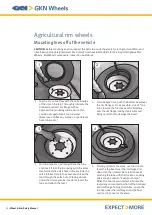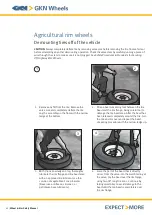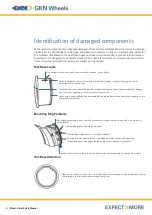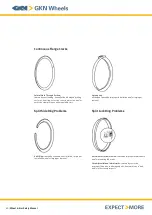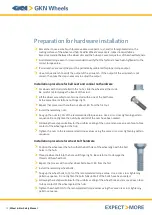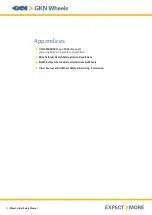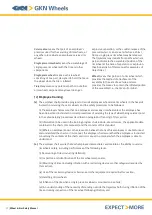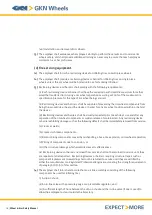
67 |
Wheel & Rim Safety Manual
Identification of damaged components
Wheel and rim components can become damaged. Check all metal surfaces for rust or corrosion buildup,
cracks in metal, bent flanges or side rings, and deep rim tool marks on rings or in gutter areas. Watch for
the problems illustrated on the next three pages and take corrective actions to prevent further damage.
Remember, it is dangerous to assemble cracked, bent, severely corroded, or sprung components. Such
items should be removed from service, discarded, and destroyed.
Rim Base Cracks
Mounting Ring Problems
Rim Base Distortion
Crack between valve locators: caused by overload.
Sheared or distorted valve locator: caused by insufficient torque, damaged stud
thread, improper clamp wedge length, and/or use of improper components.
Circumferential cracks in middle of rim: caused by overload, over-inflation.
Cracks in rim gutter: caused by overinflation, hammer damage, improper cleaning, butt weld
projection, and/or wrong rings.
Cracks across mounting bevel in a demountable rim: caused by excessive clamping torque and/or use
of improper components.
Circumferential crack at back flange radius or bead seat: caused by overload, overinflation, damage
from tire tools, deep pitting, corrosion, and/or tire abrasion.
Flange or rim gutter chorded or bent: caused by excessive or improper torque, wrong hub or clamp,
severe impact, run flat, and/or hammering on rim gutter.
Mounting ring chorded or bent: caused by excessive or improper torque, wrong hub or clamp, and/or
severe impact.
Crack at valve locators: caused by overload.
Lateral crack at spoke or clamp fit: caused by excessive or improper torque, wrong hub, or clamp.
Содержание Wheel & Rim
Страница 1: ...Wheel Rim Safety Manual...
Страница 74: ...73 Wheel Rim Safety Manual GKN OffHighway Wheels Products...









